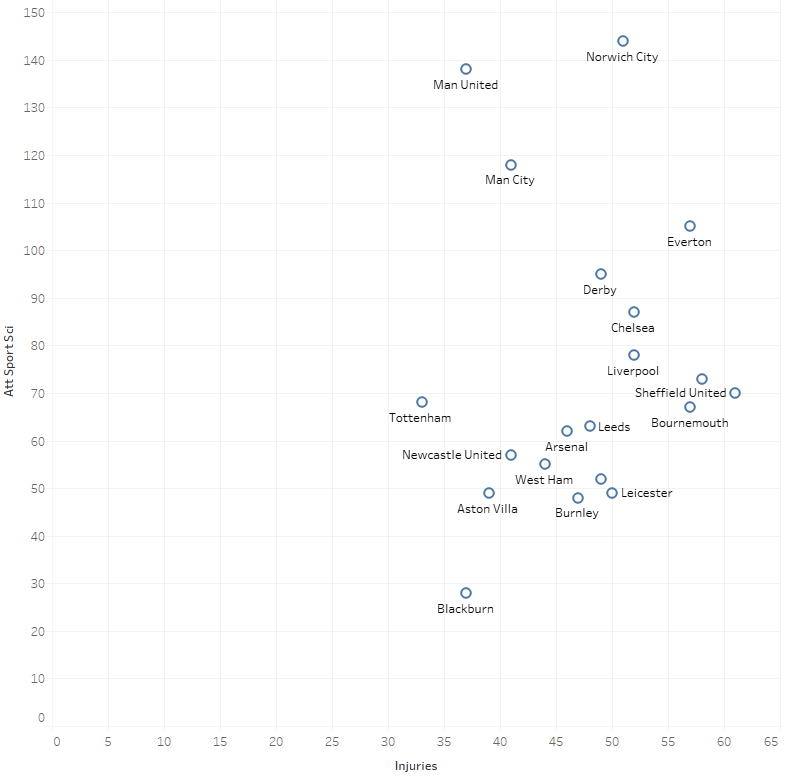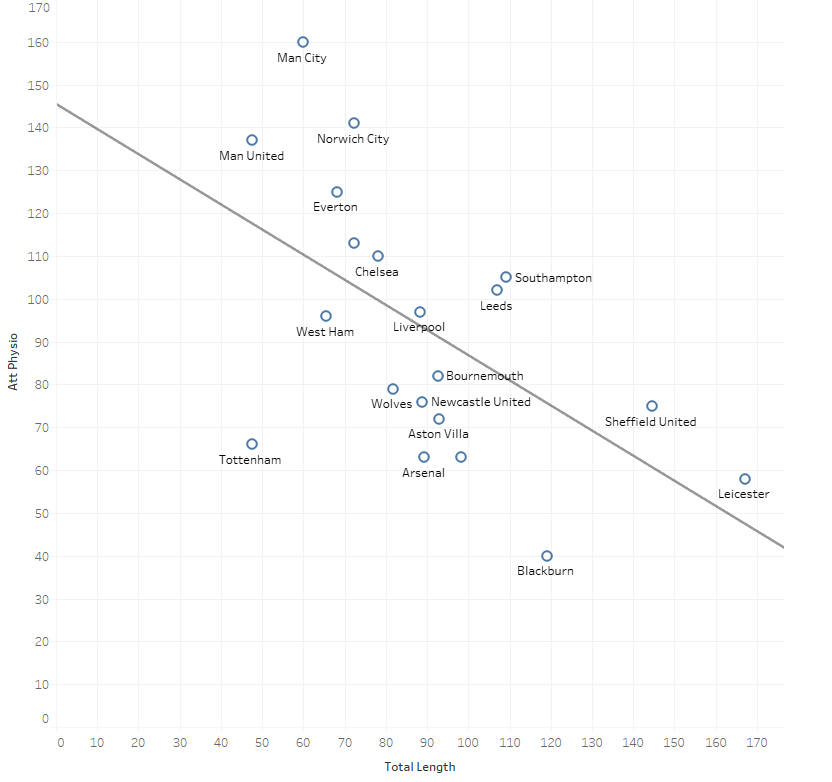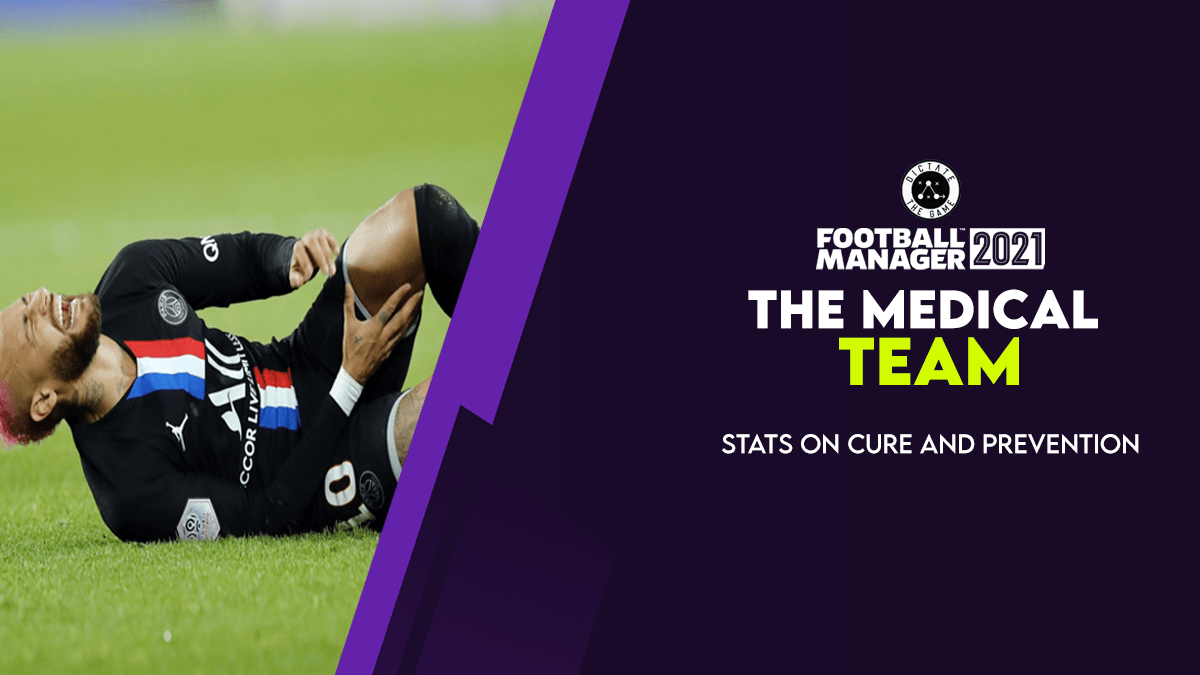
The impact of the Medical Team in FM21
In a previous article I focused on the impact of one specific member of the Medical Team, the Physio. Some experiments were run using out special league and we were able to see what sort of impact a good physio (or not) can have on things like the amount of injuries, injury length and overall performance. But the Physio is but one member of the Medical Team. From the Premiership down to the lower leagues it is common for there to be a much bigger team of people involved in keeping your superstars, journeymen and wonderkids fit.
In this article we are going to have a look at the impact the overall medical team can have, Physios, Doctors and Sport Scientists, on your player’s health.
Physio Power Recap
In the previous article the set up was fairly simple. Using the experiment league we had set up to set things like the impact of professionalism in previous Football Managers we gave team’s different ability Physio’s. After simulating 5-10 seasons worth of data we found that Physio ability seemed to have a big impact on total time out injured and average injury length. With length being reduced the better the Physio was.
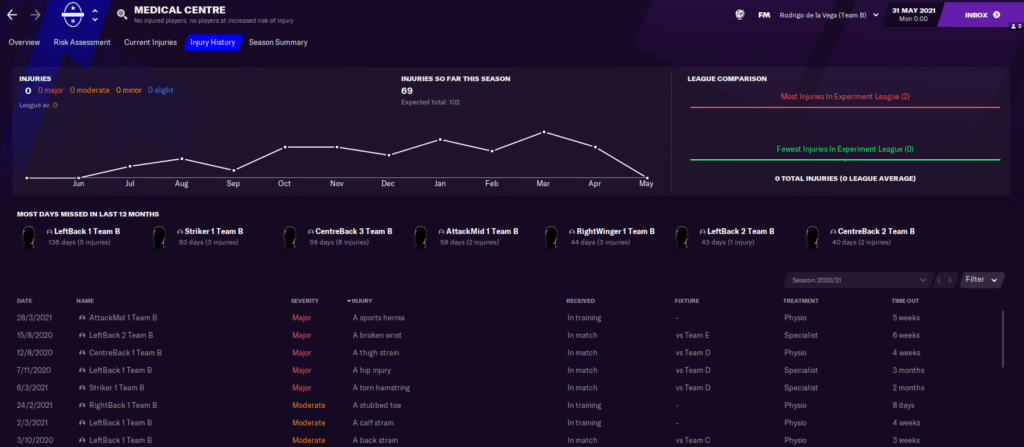
Which in turn suggests a good Physio in your Medical Team can help your overall performance, even if only directly. But as mentioned above most teams have more than just a lonely Physio. You have the option of a full on Medical Team.
Rather than run this as an experiment though we are going to see what impact this has in game, with realistic Medical Teams and set ups.
Our Medical Team?
So we have Physio’s who can help with prevention and treatment of injuries. They have been in Football Manager for a long time and are the core of any Medical Team in the game. They key attributes for these staff members tends to be, you guessed it, Physiotherapy. For a little bit more about this see the previous article.

Relatively new to the team are the Doctors and the Sport’s Scientists.
Doctors
Now this is an odd role. As you can’t actually recruit Doctor’s for your Medical Team. This is a role that the board fills for you with a greyed out or ‘ghost’ staff member. Try it out. You can’t search for them, and if you have one they have no profile you can select.
So what role do they play in the team? Well they usually act as a medical professional who sometimes will give you another option when dealing with an injury or illness. Sometimes you can use your club doctor to reduce the time out from being injured. So they seem to be (but don’t quote me) mainly in the team to reduce injury length.
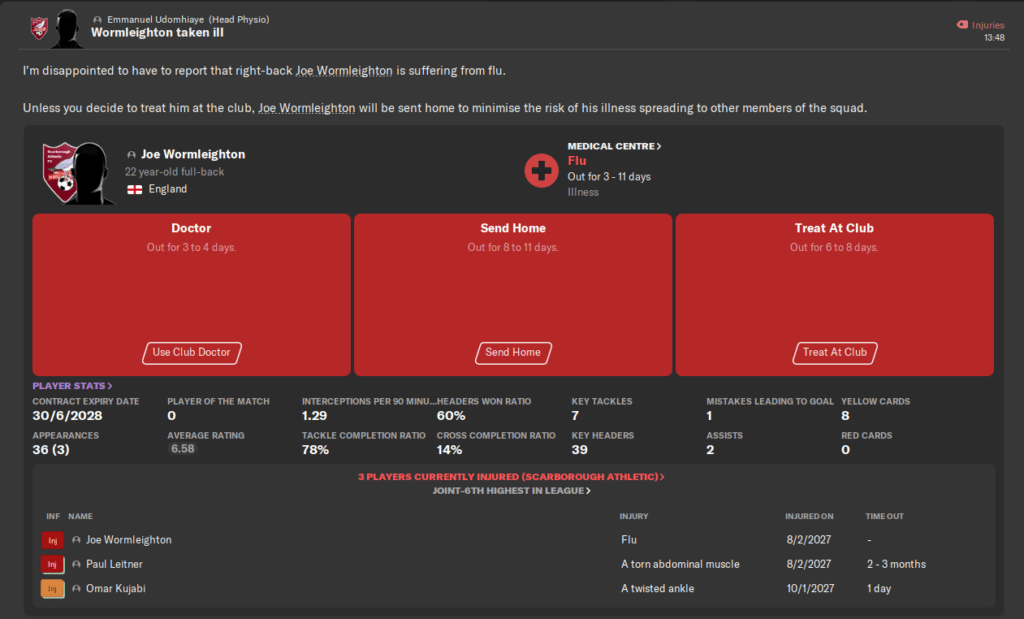
I can’t really suggest what are good attributes for your good Doctor because…you can’t see them or recruit them anyway. Just pray that your Board, who make the appointments, hire a real Doctor rather than Gillian McKeith or a homeopath.
Sports Scientists
If Physios are the ones doing the treating, then Sport Scientists are the members of the Medical Team trying to make sure people don’t get injured in the first place. They are all about preventation rather than cure. They provide the risk assessments about injury and tiredness. And as you have probably guessed it, Sports Science is the key attribute for these Medical Team members.
Current Set Up
So from the above you can see how the different members of the Medical Team work. Sports Scientists aim to prevent and reduce the number of injuries, Physio’s treat injuries and assess how long they are out for, and Doctors turn up to offer a way to reduce injury length from time to time.
A good combination of those roles should in theory help reduce the impact of injuries on your team. Either by getting players back sooner, or by reducing the chance of them being injured in the first place.
To see how well this works in practice I’ve run a simulation in the English Premiership, in the year 2027 (things are not yet underwater). At the end of the season I’ve then checked how many medical team members each club has, the total and average medical attributes, and then important information like number of injuries, amount of time injured, and average injury length. One thing to note is that I’ve not include the U23’s or youth team medics or players in this. This is all senior data.
With all this information I have then been able to see if there’s any relationship between things like the average or total Physio/Sport Science attributes, and number of staff, with the key indicators of number of injuries etc.
Medical Team Results
Before we get into the full medical team details here is an general overview of what we collected. Remember it’s the year 2027 so the teams and detail are different from your own saves.

A few stand out things to note. Having 10 or more medical staff members is not the norm. Many teams are getting away with quite limited medical teams to support them. Only 6 teams actually have a ‘big’ medical staff. It’s not the the clearest of tables though with all them numbers. Let’s break it down some more.
This is a little more telling in that most teams seem to be favouring getting good Physio attributes rather than Sport Science attributes, regardless of the number of staff. It reflected what looked like Sport Scientists being few and far between, but being more balanced in their attributes. And Physio’s being recruited more, and those that were recruited often having poor Sports Science attributes.
There seems to be a general leaning here to hiring staff to reduce injury length rather than reducing the number of injuries in the first place. A quick note here, injury length and average length are measured in weeks.
Injuries by Attributes
If you look at the graph below you can see that the total for the physio doesn’t seem to be having much effect on the total number of injuries.
We have a bit of a dense cluster here but no clear positive or negative relationship. That is to say increasing the quality of physios doesn’t appear to have an impact on lowering or increasing injuries. The same holds true when we use average physio attributes rather than overall. This is sort of to be expected. Physio’s tend to be there to treat rather than prevent.
Looking at Sport Scientists who seem to be there to prevent we get a similar picture.
A little damning for our Sports Scientists, as this holds up using averages as well. They are meant to prevent but don’t seem to have had an impact. But remember the quality of Sports Scientists was quite low, and injury amounts are more impacted by play style (intensity, pressing, tackling etc.) than recovery time is likely to be.
An interesting point for all you injury conspiracy theorists out there who are convinced there are too many injuries in the game, or in the game post patch. Most teams predicted around 121 injuries over the course of the season. In this case the highest was 61. Pretty much 50% of the expected injury load, and this is across all the teams.
Injury Length by Attributes
This is where it gets more positive for our medical staff. If we plot the physio attributes against total time teams have players out injured we can see that the better the physio team overall, the less time spent out injured across the team.
This holds up when using the averages. Likewise when we consider Sport Science attributes the higher these are the less time spent of injured. Also true when we consider averages rather than total attributes, or average length rather then total length out injured.
The real value for a good medical team seems to be coming from reducing time spent injured than stopping the injuries in the first place. This doesn’t quite fit with the role of the Sports Scientist but it’s hard to argue with the (albiet) limited data.
Injury Length by Staff Numbers
What about bodies? What about just having more people in the team? Does that help?
It looks like it does, for injury length. But it’s not as simple as just throwing staff at the problem. The more staff you have the higher your Physiotherapy and Sports Science attribute totals will be, even if the staff you hire are pants. There’s a much stronger relationship (see below for example with average Physiotherapy attributes per staff member) between good average attributes than just number of staff members. Quality not quantity is key.
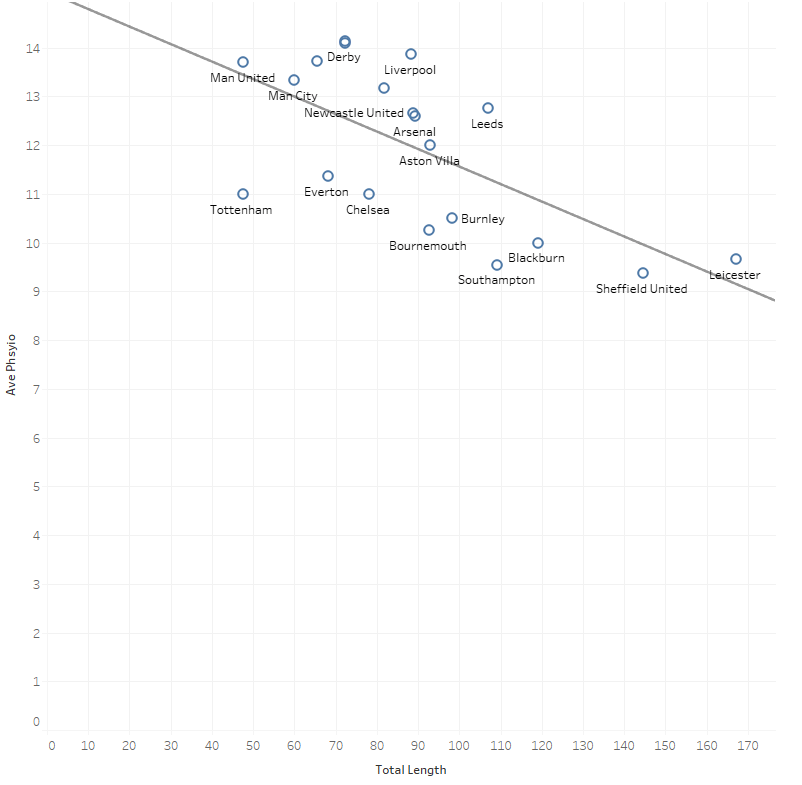
What about points?
It would be logical to assume that if you can reduce injuries, improve fitness and reduce injury length you would have a stronger team. A stronger team should then result in better performances and more points. All sensible to assume. After all there’s a reason why an injury crisis is a crisis – it can tank a season.
But there are other variables that have so much influence over performance that without a massive data set it becomes hard to really see what impact injuries (or the medical team are having). If you’re a reader of Soccernomics or the Price of Football, or even some of the Tifo work on it, you’ll know that a big predictor of league performance is actually salary.
It is influential to the point of drowing out our other variables relating to the medical team in this analysis. So for the moment we have to ignore any potential links to overall performance, and just content ourselves with the idea that in theory there should be some sort of relationship.
Is a good Medical Team worth it?
From our findings it looks like a good Medical Team can have a real impact on reducing the time spent injured for your team. In turn less time spent injured means more time playing for you, more options, stronger line ups and less spending wages on players stuck in the treatment room.
We don’t seem to have discovered much impact on stopping injuries though. There are a few potentially confounding variables. We can’t account for play style. Some playing styles lend themselves to wearing players out. Some teams will also have more injury prone players anyway. Likewise we have no control in the above simulation of how tired players were managed or rotated.
It could be that actually the value in Sports Science here is in giving you a good and accurate warning of when players need resting. Or when they are at risk. You are the human manager can then respond to that and make changes to training schedules and intensity to benefit and potentially reduce injuries. Something the AI might not be doing in quite the same way.
So when you have the option to recruit, don’t neglect Sports Scientists but do keep firmly in mind the value of good average Physiotherapy and Sports Science attributes on getting players back onto the pitch.
If you enjoyed this article please considered following us on twitter @DictateTheGame and reading one of our recent articles below.
- One-Club Man: La Cantera
- One-Club Man: Defence-First Football & Club DNA In FM24
- One-Club Man: 1st Day on The Job, Meet The Team
- The Story of One-Club Man
- FM24 Release Date Announced!


